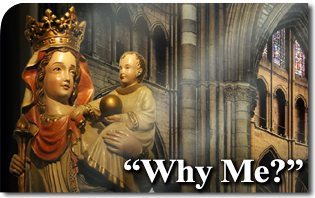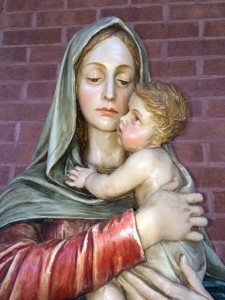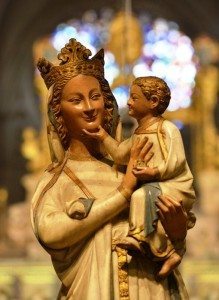 Magnificent medieval stained glass windows have sometimes been referred to as a “catechism in glass” because of the richness of the faith which their imagery conveyed.
Magnificent medieval stained glass windows have sometimes been referred to as a “catechism in glass” because of the richness of the faith which their imagery conveyed.
We could say the statues of this time period aptly captured the virtues of the holy personages. When done well they are, in their turn, truly “symbols in stone.” With more modern depictions, these symbols fall short of the reality they propose to represent.
Such is the case with this statue of Madonna with Child. One could be hard pressed to find a more downtrodden face to represent the most sweet Mother of God.
 What is most noteworthy in her countenance, however, is the deplorable defect of self-pity and a despondency that borders on despair. This only serves to accent the utter lack of tenderness towards her newborn. Overflowing with self-love, she begrudgingly assumes the role of mother towards a child who is more a burden than a blessing. The way the left side of her face sags gives the impression of a paralysis, like that seen on the face of someone who has suffered a stroke. Regardless, she looks like someone who has suffered a physical trauma that is only augmented by the fact that she is now a mother and must bear the responsibility.
What is most noteworthy in her countenance, however, is the deplorable defect of self-pity and a despondency that borders on despair. This only serves to accent the utter lack of tenderness towards her newborn. Overflowing with self-love, she begrudgingly assumes the role of mother towards a child who is more a burden than a blessing. The way the left side of her face sags gives the impression of a paralysis, like that seen on the face of someone who has suffered a stroke. Regardless, she looks like someone who has suffered a physical trauma that is only augmented by the fact that she is now a mother and must bear the responsibility.
As with most representations of this style, proper proportion and basic details are sorely lacking. Her disproportionately large hands, for example, only serve to diminish her femininity, while the child’s cheeks are so exaggeratedly puffed up they seem to conceal some type of tumor growing within. He is strangely lacking an ear and his hair is disheveled, perhaps due to a mother who is more concerned about her own affairs. With a dreamy look, he stares off at some distant point as if in search of his Heavenly Father. We are thus left with a Protestant version of Our Lady: not someone who was chosen from all eternity, but rather one who simply won the lottery but is unhappy with her good fortune and looks forward to the moment she will be free from her cross.

Such an image as this gravely distorts the reality of the Mother of God that shines so brilliantly in this charming Spanish statue called La Virgen Blanca (the White Virgin). She holds the Child Jesus as if on a pedestal, a treasure for all to admire and adore. Even more notable is the delicate placement of His right hand under her chin as if to proudly display His masterpiece, the work of His Divine Hand. They seem to vie with one another in a holy competition of affection thus showing a union of soul that was truly unique in history.
This portrayal of God’s mother shows not even the slightest sign of sadness as was seen in the other statue. Rather she is delighted and overflowing with joy to see the fulfillment of what she and all the saints of the Old Testament anxiously anticipated — the birth of the Messiah.
When the angel Gabriel first revealed to Our Lady that she would be the Mother of God, her response was perfect. Preferring God’s wishes to her own she responded, “Not my will but Thine be done.” With those sublime words, the most marvelous event in history was accomplished. This is sadly missing from the first image portraying a woman whose response to such an invitation would more likely be “Why Me?”

